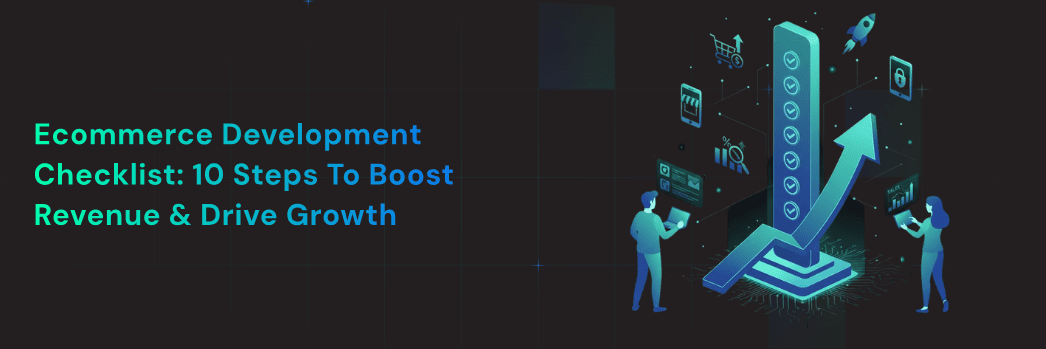The global e-commerce industry is expanding at lightning speed. From startups to established brands, every business is investing in e-commerce website development to reach more customers, streamline sales, and maximize profits.
But building an ecommerce website that truly performs isn’t just about attractive design—it’s about creating a fast, scalable, and conversion-driven platform. Whether you’re launching a new store or upgrading an existing one, this 10-step ecommerce development checklist will guide you through every phase—from planning to optimization—ensuring sustainable growth and higher revenue.
Every successful e-commerce project starts with a clear strategy. Before diving into e-commerce website development, outline your business goals and understand your target audience.
Ask yourself:
- What are your primary objectives—sales, leads, or brand awareness?
- Who is your ideal customer, and what problems do they face?
- What differentiates your store from competitors?
This step helps you make informed decisions about design, features, and functionality that align perfectly with your audience’s needs.
Your choice of platform is the foundation of your e-commerce website development journey. The platform you select determines your site’s flexibility, performance, and scalability.
Popular platforms include:
- Shopify—Simple and effective for small to mid-sized businesses.
- BigCommerce—scalable for fast-growing brands.
- WooCommerce—Great for WordPress users who prefer customization.
- Magento (Adobe Commerce)—Perfect for large enterprises with complex needs.
Evaluate your platform based on budget, features, and long-term goals. Remember—switching platforms later can be costly and time-consuming, so choose wisely from the start.
In e-commerce, design is not just about aesthetics—it’s about functionality. A well-designed website ensures users can find products quickly, understand their benefits, and make a purchase without friction.
Here’s what makes a great UX design for e-commerce:
- Intuitive navigation and clean menus
- Responsive design that adapts to all devices
- High-quality visuals and product images
- Strategic placement of CTAs like “Buy Now” or “Add to Cart”
- Minimal steps in the checkout process
Effective UX design enhances the impact of your e-commerce website development efforts by improving engagement and boosting conversion rates.
With mobile commerce accounting for more than half of online sales, your e-commerce website must be mobile-friendly. A responsive design ensures users have a seamless experience across devices.
Mobile optimization checklist:
- Fast-loading pages with compressed images
- Mobile-first design layout
- Simplified navigation and search bar
- Support for mobile payment options like Apple Pay, Google Pay, or PayPal
In modern e-commerce website development, mobile responsiveness isn’t optional—it’s essential for visibility and conversions.
Building trust is crucial for online shopping. Customers expect secure, simple, and flexible payment options.
Key best practices:
- Use SSL certificates for encrypted transactions
- Offer multiple payment gateways (credit cards, wallets, PayPal, etc.)
- Ensure PCI-DSS compliance for data security
- Enable one-click checkout for returning customers
A well-integrated payment system enhances customer confidence and improves conversion rates.
Website speed plays a massive role in e-commerce success. Studies show that even a 1-second delay in load time can reduce conversions by 7%.
To enhance performance:
- Compress and optimize images
- Enable caching and use a Content Delivery Network (CDN)
- Minimize scripts and plugins
- Invest in reliable hosting services
Fast-loading pages not only enhance user experience but also improve SEO rankings—a major factor in e-commerce website development.
A well-built ecommerce website won’t generate traffic unless it’s optimized for search engines. SEO is critical to attracting organic visitors who are ready to buy.
Core ecommerce SEO tips:
- Optimize product titles, descriptions, and URLs
- Use relevant keywords naturally (like “e-commerce website development”).
- Add alt tags to images
- Implement schema markup for better visibility in Google search results
- Publish blogs to target buyer-intent keywords
With a strong SEO foundation, your e-commerce store can rank higher, drive consistent traffic, and boost sales over time.
Modern eCommerce website development goes beyond just setting up a store—it’s about integrating tools that enhance operations and customer experience.
Useful integrations include:
- CRM tools for managing leads and customer relationships
- Email automation platforms for abandoned carts and promotions
- Analytics tools for monitoring user behavior and conversions
- Inventory management systems for tracking stock levels
Automation helps save time, reduce human errors, and improve efficiency, allowing you to focus more on growth and innovation.
Online security can make or break your e-commerce business. Customers must feel confident that their personal and payment information is safe.
Security best practices:
- Implement two-factor authentication
- Update all plugins and software regularly
- Use secure payment gateways
- Conduct periodic vulnerability scans
A secure e-commerce website fosters trust and encourages repeat purchases—essential for long-term success.
Testing is the final yet most crucial stage of e-commerce website development. Before going live, your website must be tested under real-world conditions to ensure smooth performance.
Test for:
- Functionality: Cart, checkout, and navigation
- Performance: Speed and stability under load
- Compatibility: Across browsers and devices
- Security: No vulnerabilities or weak points
Post-launch, monitor analytics and perform A/B testing to refine user experience and improve conversions.
While DIY tools are available, partnering with top app development companies in the USA or e-commerce specialists can significantly enhance the results. Experienced developers understand how to blend design, functionality, and strategy to create high-performing e-commerce websites that generate measurable ROI.
From building scalable infrastructure to optimizing UI/UX, skilled professionals ensure your e-commerce project delivers consistent business growth.

Building a successful ecommerce store isn’t just about selling products—it’s about creating a digital experience that attracts, engages, and converts. By following this 10-step e-commerce development checklist, you can ensure your website is designed for both performance and profitability.
Whether you’re a small business or an enterprise-level brand, investing in professional e-commerce website development is the smartest way to scale your business, build customer trust, and dominate your niche.
Your e-commerce website should do more than just look good—it should perform, engage, and grow alongside your business.
Search
Recent Post
- UI/UX Design Services – Expert Solutions for Web & Mobile Apps
- ECommerce website development
- Why India is the Top Destination for Outsourcing Software Development in 2025
- Why Custom App Development Is the Future of Digital Innovation
- Leading Experts in Mobile App Development for Businesses
- Innovative Software Solutions for the Logistics & Transportation Industry
Categories
- Blog (42)
- Mobile App (3)
- option1 (1)
- option2 (1)
- WordPress (2)



